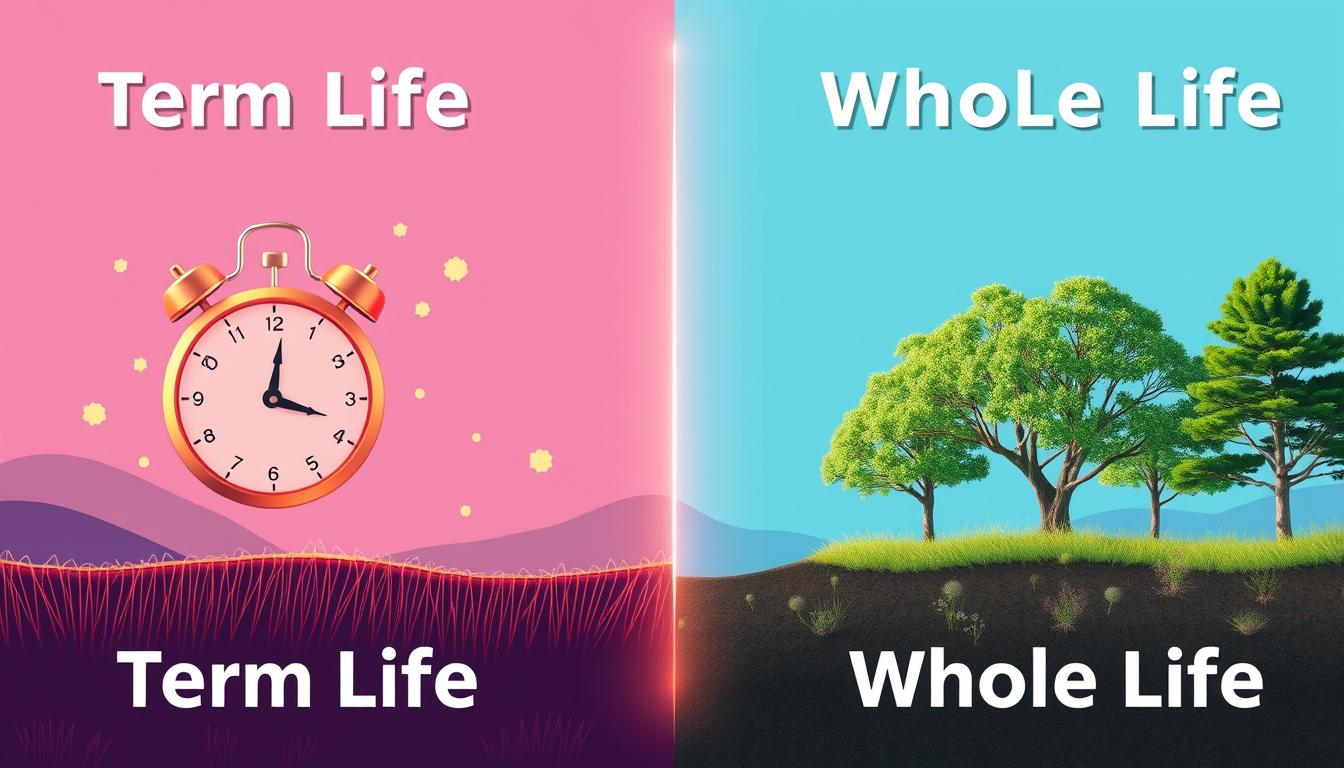Did you know the global life insurance market is set to hit $5.2 trillion by 2027? This huge industry can be overwhelming. When looking at life insurance, you’ll often come across term life vs whole life insurance. Each has its own set of features and benefits. It’s important to know the main differences to pick the right one for you and your family.
Key Takeaways
- Term life insurance provides temporary, affordable coverage for a specific duration, while whole life insurance offers lifelong protection with cash value accumulation.
- Factors like your age, health, budget, and financial goals can help you determine which insurance type best suits your needs.
- Evaluating the premium costs, death benefits, and cash value potential of each policy can aid your decision-making process.
- Consulting with a financial advisor can help you weigh the pros and cons of term life vs. whole life insurance and make an informed choice.
- Choosing the right life insurance coverage is a crucial step in protecting your loved ones and securing your family’s financial future.
Understanding the Differences Between Term Life and Whole Life Insurance
Life insurance comes in two main types: term life and whole life. Both protect your loved ones financially, but they differ in coverage length, how you pay, and how they grow in value.
Term Life Insurance: Affordable Protection for a Specified Duration
Term life insurance covers you for a set time, usually 1 to 30 years. It’s often cheaper because the cost depends on your age and coverage length. This policy mainly offers death benefits to cover things like your mortgage, childcare, or other bills if you pass away during the term.
Whole Life Insurance: Lifelong Coverage with Cash Value Accumulation
Whole life insurance is a permanent policy that covers you for life if you keep paying policy premiums. It gives a guaranteed death benefit and lets your policy’s cash value grow. This cash value can be used during your life if you need it.
Term Life vs Whole Life Insurance: Factors to Consider
Choosing between term life and whole life insurance requires careful thought. You should look at policy premiums, death benefits, cash value accumulation, and insurance coverage.
First, let’s talk about premium costs. Term life insurance usually has lower policy premiums. This makes it cheaper for young people or those watching their spending. But, whole life insurance has the perk of cash value accumulation. This can be used later in life.
Next, think about the death benefits. Term life insurance covers you for a set time, like 10 or 20 years. If you die during this time, it pays out a lump sum to your loved ones. Whole life insurance, however, covers you for life. It guarantees a death benefit no matter when you pass away.
The cash value accumulation is key too. Whole life policies grow a cash value that you can borrow against or take out. This can help with financial flexibility and in retirement. Term life insurance doesn’t have a cash value part.
So, the choice between term life vs. whole life insurance depends on your financial goals and budget. Think about what you need and talk to a financial advisor. They can help pick the best insurance coverage for you.

Conclusion
Choosing between term life and whole life insurance isn’t easy. Each type has its own benefits, depending on your financial situation, coverage needs, and goals.
Term life insurance is great for protecting your loved ones during your working years. It’s affordable and covers you for a set time. On the other hand, whole life insurance gives you coverage for life and can grow in value over time. It’s a good choice for those who want a solid financial plan.
When deciding between term life vs whole life insurance, think about your budget, what you need covered, and your financial goals. Look at the different life insurance types and how they match your needs. By carefully considering your options, you can pick the best choice to protect your family and secure your future.
FAQ
What is the main difference between term life and whole life insurance?
Term life insurance covers you for a set time, like 1 to 30 years. Whole life insurance covers you for your whole life. This makes whole life insurance last longer.
How do the premium costs compare between term life and whole life insurance?
Term life insurance is cheaper, especially for young people. It covers you for a shorter time. Whole life insurance costs more but covers you for life.
What is the key benefit of whole life insurance?
Whole life insurance builds cash value over time. You pay premiums, and some money is invested. This cash value can be borrowed or withdrawn if you need it.
How do the death benefits differ between term life and whole life insurance?
Term life insurance pays out a death benefit if you die within the policy term. Whole life insurance pays a death benefit at any time if premiums are paid.
Which type of insurance coverage is better for long-term financial planning?
Whole life insurance is better for long-term planning because it grows cash value. This cash can be used for retirement, emergencies, or other needs. Term life insurance is cheaper but doesn’t grow cash value.
When is term life insurance more suitable?
Term life insurance suits those needing temporary coverage. This includes young families or those on a tight budget. It’s good until kids grow up or the mortgage is paid.
How does the duration of coverage differ between term life and whole life insurance?
Term life insurance covers you for a set time, like 1 to 30 years. If not renewed, it ends. Whole life insurance covers you for life if premiums are paid, ensuring a death benefit at any time.
